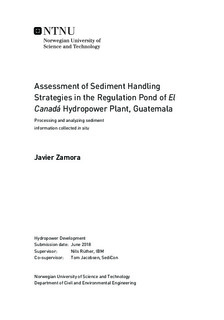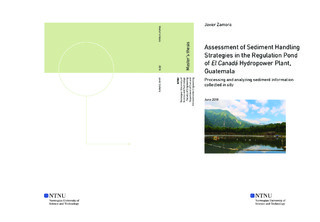| dc.description.abstract | El Canadá HPP is a 47 MW run-of-river hydropower plant located in Guatemala. The power plant is highly affected by sediments, especially its off-stream regulation pond. Some sediment handling strategies have been implemented at the power plant, including the installation and operation of one conventional dredge and one hydrosuction dredge. The present study aims to analyze and assess the sediment challenges in the power plant and the adopted sediment handling strategies.
The required information for the assessment was collected during a field trip to the power plant. A back-calculation method to estimate sediment yield in the catchment was successfully developed using the collected information. Finally, operation data of the power plant and the two dredges was used to estimate the annual costs related to sediment problems in the power plant.
The back-calculation method showed an average sediment yield in the catchment of 578,000 ton/year, or 703 ton/year/km2. From that sediment load, an average of 117,000 tons of sediments are deposited in the regulation pond every year, representing nearly 107,000 m3, which is approximately 50% of the total volume of the pond.
Sediment samples taken in the pond showed that the sediment deposits are mainly composed of silt and have a cohesion of 12 kPa. Sediment removal capacity of the two dredges was measured, giving values of 33.2 m3/h for the hydrosuction dredge and 17.1 m3/h for the conventional dredge. Despite the values are lower than reference values given by the manufacturers, the removal capacity is still enough to deal with the annual sediment income. Estimated unit cost of hydrosuction dredging is US$1.5/m3, while for the conventional dredge is US$2.8/m3.
Cost analysis using actual energy prices for every year and a fixed average energy price of the period showed that the sediment-related costs have been reduced after the implementation of the hydrosuction dredge in 2011. Using the fixed average energy price, the net benefit of introducing the hydrosuction dredge was US$607,600 per year on average. The analysis proves that the cost of implementing sediment handling strategies is considerably lower than the cost of the sediment impacts. | |

